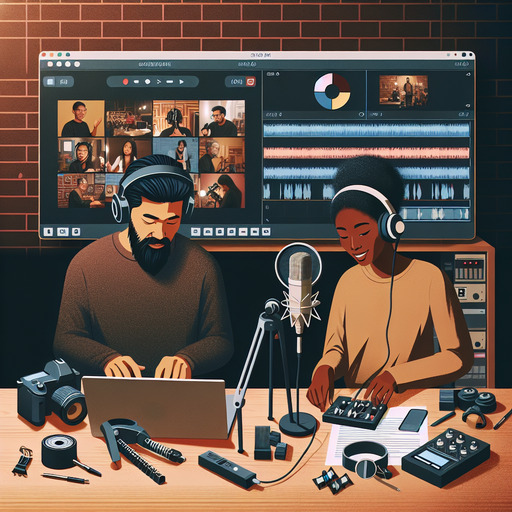
-
Table of Contents
Discover how to use video podcasting to build a powerful personal brand! Learn the strategies and tips to elevate your presence and connect with your audience. Start building your brand now!
Introduction
In today’s digital age, video podcasting has emerged as a powerful tool for individuals looking to build and enhance their personal brand. By combining the engaging elements of video with the informative nature of podcasts, video podcasting offers a unique platform to showcase expertise, personality, and authenticity. This medium allows for a deeper connection with the audience, as viewers can see and hear the podcaster, creating a more intimate and relatable experience. To effectively use video podcasting for personal branding, it is essential to focus on high-quality content, consistent production, and strategic promotion. By doing so, individuals can establish themselves as thought leaders in their niche, attract a loyal following, and ultimately, elevate their personal brand to new heights.
How to Use Video Podcasting to Build a Personal Brand: A Comprehensive Guide to Podcast Video Production, Equipment, Setup, Editing, Tips, Marketing, Gear, Recording, and Hosting
Building a personal brand through video podcasting is an increasingly popular and effective strategy. The visual and auditory elements of video podcasts create a more engaging experience for your audience, allowing you to connect on a deeper level. To get started, you need to understand the essentials of podcast video production, including the necessary equipment, setup, editing, and marketing strategies.
First and foremost, selecting the right equipment is crucial. A high-quality camera is essential for capturing clear and professional-looking video. While many podcasters start with a webcam, investing in a DSLR or mirrorless camera can significantly enhance the visual quality. Additionally, good lighting is vital. Softbox lights or ring lights can help eliminate shadows and create a flattering appearance. Equally important is the audio quality; a high-quality microphone, such as a condenser or dynamic mic, ensures that your voice is clear and free from background noise.
Once you have your equipment, the next step is setting up your recording space. Choose a quiet location with minimal background noise and distractions. Consider the backdrop; a clean, uncluttered background or a branded set can make a significant difference in the overall aesthetic. Position your camera at eye level to create a natural and engaging connection with your audience. Ensure that your lighting is positioned to eliminate shadows and highlight your face evenly.
After recording, the editing process begins. Editing software like Adobe Premiere Pro, Final Cut Pro, or even free options like DaVinci Resolve can help you polish your video. During editing, focus on maintaining a consistent flow and pacing. Cut out any unnecessary pauses or mistakes, and consider adding graphics, text overlays, or transitions to enhance the viewer’s experience. Pay attention to audio quality during editing; background music or sound effects can add a professional touch, but ensure they do not overpower your voice.
Marketing your video podcast is the next critical step. Start by creating a compelling title and description that includes relevant keywords to improve searchability. Utilize social media platforms to promote your episodes, engaging with your audience through comments and shares. Collaborate with other podcasters or influencers in your niche to expand your reach. Additionally, consider creating a dedicated website or blog to host your episodes and provide additional content, such as show notes or transcripts, which can improve SEO and accessibility.
Consistency is key in building a personal brand. Establish a regular posting schedule and stick to it. This reliability helps build trust with your audience and keeps them coming back for more. Engage with your audience by responding to comments and feedback, and consider incorporating their suggestions into future episodes. This interaction not only builds a loyal community but also provides valuable insights into what your audience enjoys and expects.
Finally, hosting your video podcast on the right platform is essential. YouTube is a popular choice due to its vast audience and robust search capabilities. However, consider also uploading your content to podcast hosting platforms like Libsyn, Podbean, or Anchor, which can distribute your podcast to various directories, including Apple Podcasts and Spotify. This multi-platform approach ensures that your content reaches a broader audience.
In conclusion, video podcasting is a powerful tool for building a personal brand. By investing in quality equipment, creating a professional setup, meticulously editing your content, and effectively marketing your episodes, you can create a compelling and engaging video podcast that resonates with your audience. Consistency and audience engagement are crucial in establishing and growing your personal brand, ensuring long-term success in the ever-evolving digital landscape.
Q&A
1. **How can video podcasting help build a personal brand?**
– **Showcase Expertise:** Share knowledge and insights on topics related to your niche to establish yourself as an authority.
– **Engage with Audience:** Use video to create a more personal connection with your audience, making your brand more relatable.
– **Consistency:** Regularly publish episodes to build a loyal following and reinforce your brand message.
– **Cross-Promotion:** Share your video podcasts on social media, blogs, and other platforms to reach a wider audience.
– **Guest Appearances:** Invite industry experts to your podcast to add credibility and attract their followers to your brand.
– **Visual Branding:** Use consistent visuals, such as logos and color schemes, to reinforce your brand identity.
– **SEO Benefits:** Optimize video titles, descriptions, and tags to improve search engine visibility and attract more viewers.